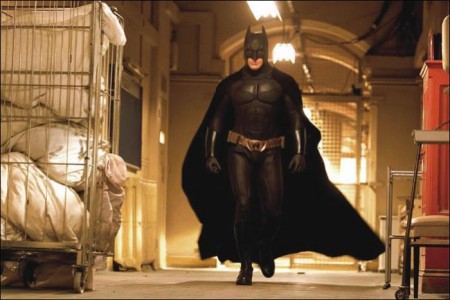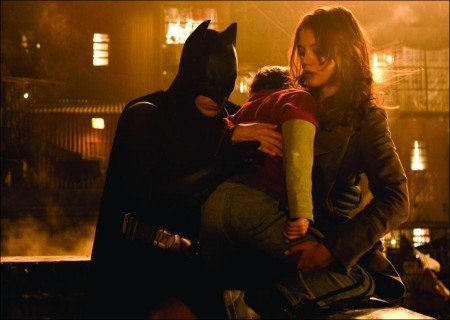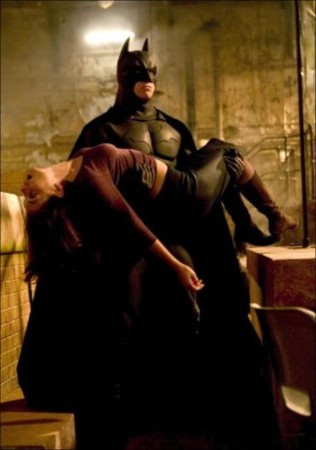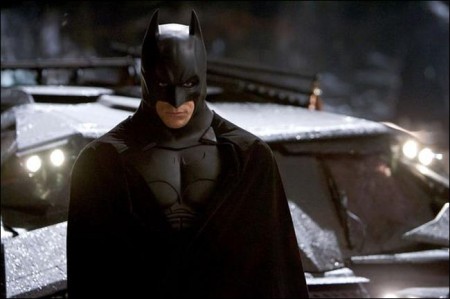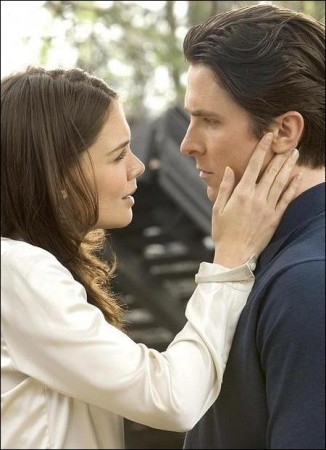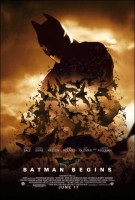Tagline: How does one man change the world?
Explores the origins of the Batman legend and the Dark Knight’s emergence as a force for good in Gotham. Christian Bale stars as Bruce Wayne / Batman; Michael Caine as his trusted butler Alfred; Gary Oldman as Lieutenant James Gordon, a detective on the Gotham police force; Katie Holmes as a childhood friend of Wayne’s; Liam Neeson as Wayne’s mentor, Henri Ducard; Ken Watanabe as the villainous Ra’s Al Ghul; and Morgan Freeman as Lucius Fox, a former board member and sidelined employee of Wayne Enterprises.
How does one man change the world? It’s a question that haunts Bruce Wayne (Christian Bale) like the specter of his parents, gunned down before his eyes in the streets of Gotham on a night that changed his life forever.
Tormented by guilt and anger, battling the demons that feed his desire for revenge and his need to honor his parents’ altruistic legacy, the disillusioned industrial heir vanishes from Gotham and secretly travels the world, seeking the means to fight injustice and turn fear against those who prey on the fearful.
In his quest to educate himself in the ways of the criminal mind, Bruce is mentored by a mysterious man called Ducard (Liam Neeson) in the mastery of the physical and mental disciplines that will empower him to fight the evil he has vowed to destroy. He soon finds himself the target of recruiting efforts by the League of Shadows, a powerful, subversive vigilante group headed by enigmatic leader Ra’s al Ghul (Ken Watanabe).
Bruce returns to Gotham to find the city devoured by rampant crime and corruption. Wayne Enterprises, his family’s former bastion of philanthropic business ideals, now rests in the hands of CEO Richard Earle, a man more concerned with taking the company public than serving the public good.
Meanwhile, Bruce’s close childhood friend Rachel Dawes (Katie Holmes), now an Assistant District Attorney, can’t secure a conviction of the city’s most notorious criminals because the justice system has been so deeply polluted by scum like crime boss Carmine Falcone (Tom Wilkinson). It doesn’t help that prominent Gotham psychiatrist Dr. Jonathan Crane (Cillian Murphy) bolsters insanity defenses for Falcone’s thugs in exchange for nefarious favors that serve his own devious agenda.
With the help of his trusted butler Alfred (Michael Caine), detective Jim Gordon (Gary Oldman) — one of the few good cops on the Gotham police force — and Lucius Fox (Morgan Freeman), his ally at the Wayne Enterprises’ Applied Sciences division, Bruce Wayne unleashes his awe-inspiring alter-ego: Batman, a masked crusader who uses strength, intellect and an array of high tech weaponry to fight the sinister forces that threaten to destroy the city.
The Origins of the Dark Knight
Criminals are a superstitious, cowardly lot. So my disguise must be able to strike terror into their hearts. I must be a creature of the night. – Bruce Wayne, AKA Batman, Detective Comics #33
He first appeared in 1939, a wraith silhouetted against the Gotham skyline. Mysterious and menacing, “The Bat-Man” surfaced as the self-appointed guardian of Gotham City, a winged gargoyle living in the shadows between hero and vigilante. In the six decades since, he has come to be known as the Dark Knight, a complex man who transformed himself through sheer force of will into a symbol of hope and justice for a city rotting with corruption and decay.
Created for DC Comics by artist Bob Kane, Batman made his debut in Detective Comics #27 (May, 1939 issue). The superhero’s 66-year history represents an unprecedented cultural phenomenon spanning radio serials, live action and animated television series, feature films, interactive games, and legions of comic books.
“Batman is one of the most psychologically interesting characters in our cultural history,” says Paul Levitz, President and Publisher of DC Comics, the largest Englishlanguage publisher of comics in the world and home to such iconic characters as Batman, Superman, Wonder Woman and the Sandman. “Batman isn’t a guy who finds himself endowed with superpowers and simply says I’ll do good with them because I’m a good person. This is a man who watched his parents die and then had to decide how to respond. He’s tortured by feelings of guilt and anger and his desire for vengeance, yet he sets out to become a transformative being, someone who can change the world.”
“What’s always been fascinating about Batman is that he is a hero driven by quite negative impulses,” says Batman Begins director and co-screenwriter Christopher Nolan. “Batman is human, he’s flawed. But he’s someone who has taken these very powerful, selfdestructive emotions and made something positive from them. To me, that makes Batman an extraordinarily relevant figure in today’s world.”
A superhero with no superpowers, Batman’s ambitious quest to forge his mind and body into a living, breathing weapon against injustice inspires both fear and admiration. “What distinguishes Batman from his counterparts is that he’s a hero anyone can aspire to be,” says co-screenwriter David Goyer, known for adapting the other-worldly realms of superheroes and fantastical characters into inventive, action-packed hit films such as the Blade series, Crow: City of Angels and Dark City. “You could never be Superman, you could never be The Incredible Hulk, but anybody could conceivably become Batman. If you trained hard enough, if you tried hard enough, maybe, just maybe, you could become Batman.”
Batman Begins explores the origins of the Batman legend and the Dark Knight’s emergence as a force for good in Gotham. “What I wanted to do was tell the Batman story I’d never seen, the one that the fans have been wanting to see – the story of how Bruce Wayne becomes Batman,” says Nolan, whose taut, provocative psychological thrillers Memento and Insomnia established him as a bold new talent with a keen sense of character and a remarkably assured directing style.
A character-driven adventure powered by large-scale action and layered with the complexities of the human condition, Batman Begins represents the first full telling of Bruce Wayne’s quest to become Batman, detailing how and why he acquires the skills, tools and technology to create his intimidating alter-ego.
“There is no one definitive account of Batman’s origins,” says Nolan, “but throughout the interpretations of his character over the years, there are key events that make Batman who he is and make his story the great legend that it has come to be. There were also a lot of very interesting gaps in the mythology that we were able to interpret ourselves and bring in our own ideas of how Bruce Wayne and Batman would have evolved specifically.”
In recounting Bruce Wayne’s odyssey from his traumatic childhood to his emergence as Batman, Nolan wanted to present “a more realistic take on his story than we’ve seen in previous incarnations of the character. I wanted to treat it with a degree of gravity and with a sense of epic scope, but set in a world that is firmly grounded in reality.”
“One of Chris’ mantras when we were working on the script was It has to be real, it has to be real,” recalls Goyer, whose points of reference while crafting the screenplay with Nolan included the classic action adventure films Lawrence of Arabia, The Man Who Would Be King, Blade Runner and the James Bond epic On Her Majesty’s Secret Service.
“We applied that philosophy to every aspect of the story, even down to the most minute details – Why are the bat ears so tall? Why does the Batmobile look the way it does? We developed a logical explanation for everything that Bruce Wayne does and for every device he acquires in the film.”
Nolan and Goyer took an unconventional approach to their collaboration. As they worked on the script at Nolan’s home, production designer Nathan Crowley began creating conceptual designs of Gotham City and models of the re-imagined Batmobile in the garage.
“I wanted to focus on the design of the new Batmobile during the script writing stage because I felt that everything we were trying to do that defines our approach to telling this story, our emphasis on grounding the characters and the film in reality, would be evident in the look and feel of that vehicle,” the director notes.
“I think that from now on, any film that we make, we’ll start in the garage,” jokes producer Emma Thomas. “The synergy of having Chris, David and Nathan working simultaneously in the same creative space worked amazingly well and it advanced our development and production process considerably.”
Portraying the full arc of Bruce Wayne’s story in a realistic manner required Nolan and Goyer to explore the complex psychology of the man behind the myth. “For me, the most exciting aspect of telling this story is getting inside Bruce Wayne’s head and going on that journey with him,” says Nolan, “so that we experience the process of becoming Batman through his eyes.”
In Nolan and Goyer’s telling, Thomas Wayne instills in his young son a sense of philanthropy and a love for the city that has benefited greatly from the altruism of its wealthiest family, and lays a foundation for Bruce’s ideals of justice and fairness. His belief system is all but shattered when his parents are gunned down before his eyes, victims of the fear and desperation spawned by Gotham’s rampant crime and collapsing economy. To make matters worse, Bruce blames himself for their murders.
Consumed by guilt and anger, isolated by his status and pain, Bruce begins a lifelong struggle to reconcile his rage and thirst for vengeance with his need to honor his parents’ philanthropic legacy.
“This boy has everything ripped away from him in an instant,” Goyer muses. “As a result, he has to deal with intense guilt, anger, loneliness and confusion. He is so pained by what happened that he ultimately has to leave Gotham in search of answers.”
“It’s a journey that never ends,” says Christian Bale, the versatile actor known for deftly segueing between acclaimed performances in provocative independent films such as Laurel Canyon, American Psycho and Velvet Goldmine, and starring roles in large-scale action adventures like Shaft and Reign of Fire. “He is in a constant battle with himself internally. He must continually assess his actions and control his demons, overcoming the pull toward selfdestruction and the negative emotions that will destroy his life if he allows them to.”
“Christian Bale was the ideal choice to play a young Bruce Wayne, particularly a Bruce Wayne still struggling very much with the demons that drive him to become Batman,” says Nolan. “He is a very complex character who exists on the razor’s edge between good and bad. Christian embodies that sense of danger and ambiguity that can be channeled into something very positive and very powerful. He has that kind of intensity, that fire burning inside. You look into his eyes and you believe that this man would go to those extremes.”
“Bruce Wayne is an ordinary man who has made himself extraordinary, through sheer determination and self-discipline,” producer Chuck Roven observes. “Christian exemplifies this kind of passion, dedication and commitment. He has a wonderful presence as Bruce Wayne and Batman, and brings an amazing power to his performance, both physically and emotionally.”
Bale was intrigued by Nolan’s vision for the film, both in his desire to explore the darker aspects of the Batman character and his goal to give audiences what the director deems “the cinematic equivalent of reading a great graphic novel.”
“Graphic novels like Arkham Asylum presented a Batman that I had never seen before,” says Bale, who discovered the Dark Knight several years ago at a comic book store in Santa Monica. “He was dark and dangerous and more interesting than any other comic book hero or villain.”
One way in which Nolan and Goyer grounded Bruce Wayne’s story in reality while marrying milestones in the mythology with their own interpretation of events is through the film’s theme of fear. In the story, young Bruce’s accidental discovery of the bat-filled caverns beneath Wayne Manor results in a harrowing encounter with the terrifying creatures, leaving him permanently haunted by the memory. Nolan and Goyer fused this seminal experience with Bruce’s subsequent guilt over his parents’ deaths, making his decision to remold himself in the image of a creature that wracks him with such fear and anxiety all the more remarkable and resonant.
“It’s fascinating to me,” Nolan remarks, “the idea of a person who would confront his innermost fear, and then attempt to become it.”
“The bat is a very personal symbol to him,” Bale explains. “It’s one that induced fear in him as a child, and as an adult is a constant reminder of the night his parents were murdered and of his own feelings of guilt. When he returns to Gotham after honing his mental and physical skills, the bat persona becomes the clear answer to his need for a disguise. He uses it as a means to intimidate others and manipulate their fears, as well as master his own.”
While superheroes typically face the challenge of living as both a public personality and a private force for change, Bruce Wayne grapples with the necessity of presenting two very different personas in public while carefully guarding his true identity.
“It’s not just a duality between Batman and Bruce Wayne that I was interested in exploring,” Nolan reveals. “To truly represent his journey, we needed to portray the three distinct facets of his character: Batman, the iconic masked warrior who is the channel of Bruce’s inner rage; the private Bruce Wayne, a damaged man who dedicates his life to ridding Gotham City of the evil that took his parents’ lives; and the third individual, the public face of Bruce Wayne – a spoiled playboy, the last person anyone in Gotham society would suspect of caring about the city’s decline, let alone of being Batman. The public Bruce Wayne persona is as much a mask as the mask that Batman wears.”
“Bruce Wayne doesn’t want people to ever think that he’s capable of idealism or compelled to help those in need,” Roven elaborates, “so he presents himself as a very clichéd, womanizing, sports car-driving socialite. But it’s all just a front. It’s a game that he’s playing. He reveals the genuine Bruce Wayne only to a very few people he knows he can trust.”
While the circumstances that motivate Bruce Wayne to become Batman are extreme, everyone can relate to the pain of loss, outrage at injustice, and the need for an outlet through which to vent anger and turn negative emotions into positive actions. It’s the fact that it’s possible to be him – if you have the strength, stamina and selflessness to actually become him – that makes Batman so compelling and so enduring.
“He’s unpredictable, his actions may be questionable, his motivations less than pure. Yet we know he is ultimately a force for good,” Bale says. “This complexity makes Batman the coolest of superheroes.”
These production notes provided by Warner Bros. Pictures.
Batman Begins
Starring: Christian Bale, Katie Holmes, Ken Watanabe, Morgan Freeman, Michael Caine
Directed by: Christopher Nolan
Screenplay by: David Goyer
Release Date: June 15th, 2005
MPAA Rating: PG-13 for intense action violence, disturbing images.
Studio: Warner Bros. Pictures
Box Office Totals
Domestic: $205,343,774 (55.2%)
Foreign: $166,510,009 (44.8%)
Total: $371,853,783 (Worldwide)
